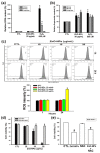ZnO Nanoparticles Induced Caspase-Dependent Apoptosis in Gingival Squamous Cell Carcinoma through Mitochondrial Dysfunction and p70S6K Signaling Pathway
- PMID: 32111101
- PMCID: PMC7084801
- DOI: 10.3390/ijms21051612
ZnO Nanoparticles Induced Caspase-Dependent Apoptosis in Gingival Squamous Cell Carcinoma through Mitochondrial Dysfunction and p70S6K Signaling Pathway
Abstract
Zinc oxide nanoparticles (ZnO-NPs) are increasingly used in sunscreens, food additives, pigments, rubber manufacture, and electronic materials. Several studies have shown that ZnO-NPs inhibit cell growth and induce apoptosis by the production of oxidative stress in a variety of human cancer cells. However, the anti-cancer property and molecular mechanism of ZnO-NPs in human gingival squamous cell carcinoma (GSCC) are not fully understood. In this study, we found that ZnO-NPs induced growth inhibition of GSCC (Ca9-22 and OECM-1 cells), but no damage in human normal keratinocytes (HaCaT cells) and gingival fibroblasts (HGF-1 cells). ZnO-NPs caused apoptotic cell death of GSCC in a concentration-dependent manner by the quantitative assessment of oligonucleosomal DNA fragmentation. Flow cytometric analysis of cell cycle progression revealed that sub-G1 phase accumulation was dramatically induced by ZnO-NPs. In addition, ZnO-NPs increased the intracellular reactive oxygen species and specifically superoxide levels, and also decreased the mitochondrial membrane potential. ZnO-NPs further activated apoptotic cell death via the caspase cascades. Importantly, anti-oxidant and caspase inhibitor clearly prevented ZnO-NP-induced cell death, indicating the fact that superoxide-induced mitochondrial dysfunction is associated with the ZnO-NP-mediated caspase-dependent apoptosis in human GSCC. Moreover, ZnO-NPs significantly inhibited the phosphorylation of ribosomal protein S6 kinase (p70S6K kinase). In a corollary in vivo study, our results demonstrated that ZnO-NPs possessed an anti-cancer effect in a zebrafish xenograft model. Collectively, these results suggest that ZnO-NPs induce apoptosis through the mitochondrial oxidative damage and p70S6K signaling pathway in human GSCC. The present study may provide an experimental basis for ZnO-NPs to be considered as a promising novel anti‑tumor agent for the treatment of gingival cancer.
Keywords: gingival cancer; p70S6K pathway; superoxide; zinc oxide nanoparticles.
Conflict of interest statement
The authors declare no conflict of interest.
Figures








Similar articles
-
Zinc oxide nanoparticles induce human multiple myeloma cell death via reactive oxygen species and Cyt-C/Apaf-1/Caspase-9/Caspase-3 signaling pathway in vitro.Biomed Pharmacother. 2020 Feb;122:109712. doi: 10.1016/j.biopha.2019.109712. Epub 2019 Dec 30. Biomed Pharmacother. 2020. PMID: 31918281
-
Role of Cyt-C/caspases-9,3, Bax/Bcl-2 and the FAS death receptor pathway in apoptosis induced by zinc oxide nanoparticles in human aortic endothelial cells and the protective effect by alpha-lipoic acid.Chem Biol Interact. 2016 Oct 25;258:40-51. doi: 10.1016/j.cbi.2016.08.013. Epub 2016 Aug 17. Chem Biol Interact. 2016. PMID: 27544635
-
Zinc oxide nanoparticles induce apoptosis and autophagy in human ovarian cancer cells.Int J Nanomedicine. 2017 Sep 5;12:6521-6535. doi: 10.2147/IJN.S140071. eCollection 2017. Int J Nanomedicine. 2017. PMID: 28919752 Free PMC article.
-
Cutting-edge nanotechnology: unveiling the role of zinc oxide nanoparticles in combating deadly gastrointestinal tumors.Front Bioeng Biotechnol. 2025 Mar 20;13:1547757. doi: 10.3389/fbioe.2025.1547757. eCollection 2025. Front Bioeng Biotechnol. 2025. PMID: 40182988 Free PMC article. Review.
-
Recent Advances in Zinc Oxide Nanoparticles (ZnO NPs) for Cancer Diagnosis, Target Drug Delivery, and Treatment.Cancers (Basel). 2021 Sep 12;13(18):4570. doi: 10.3390/cancers13184570. Cancers (Basel). 2021. PMID: 34572797 Free PMC article. Review.
Cited by
-
Enhanced reduction of polymicrobial biofilms on the orthodontic brackets and enamel surface remineralization using zeolite-zinc oxide nanoparticles-based antimicrobial photodynamic therapy.BMC Microbiol. 2021 Oct 7;21(1):273. doi: 10.1186/s12866-021-02324-w. BMC Microbiol. 2021. PMID: 34620084 Free PMC article.
-
Zinc oxide nanoparticles derived from Penicillium griseofulvum mitigate DMBA/TPA-promoted mice skin carcinogenesis by modulating NF-ĸB associated signalling.Naunyn Schmiedebergs Arch Pharmacol. 2025 Jan;398(1):891-902. doi: 10.1007/s00210-024-03311-4. Epub 2024 Jul 30. Naunyn Schmiedebergs Arch Pharmacol. 2025. PMID: 39080011
-
Biosynthesis, Characterization, and Augmented Anticancer Activity of ZrO2 Doped ZnO/rGO Nanocomposite.J Funct Biomater. 2023 Jan 9;14(1):38. doi: 10.3390/jfb14010038. J Funct Biomater. 2023. PMID: 36662085 Free PMC article.
-
Effects of green synthesized zinc nanoparticles alone and along with albendazole against hydatid cyst protoscoleces.Ann Med Surg (Lond). 2022 May 11;78:103746. doi: 10.1016/j.amsu.2022.103746. eCollection 2022 Jun. Ann Med Surg (Lond). 2022. PMID: 35600184 Free PMC article.
-
SnO2-Doped ZnO/Reduced Graphene Oxide Nanocomposites: Synthesis, Characterization, and Improved Anticancer Activity via Oxidative Stress Pathway.Int J Nanomedicine. 2021 Jan 8;16:89-104. doi: 10.2147/IJN.S285392. eCollection 2021. Int J Nanomedicine. 2021. PMID: 33447029 Free PMC article.
References
-
- Goud E., Malleedi S., Ramanathan A., Wong G.R., Hwei Ern B.T., Yean G.Y., Ann H.H., Syan T.Y., Zain R.M. Association of Interleukin-10 Genotypes and Oral Cancer Susceptibility in Selected Malaysian Population: A Case- Control Study. Asian Pac. J. Cancer Prev. 2019;20:935–941. doi: 10.31557/APJCP.2019.20.3.935. - DOI - PMC - PubMed
MeSH terms
Substances
Grants and funding
LinkOut - more resources
Full Text Sources
Molecular Biology Databases
Miscellaneous

